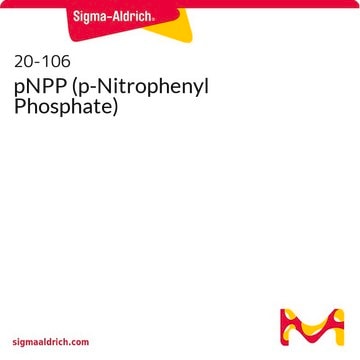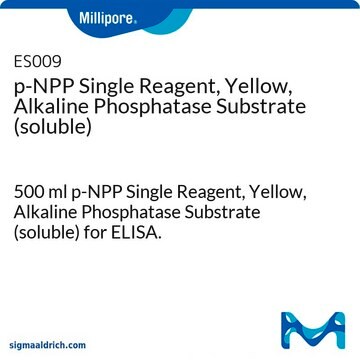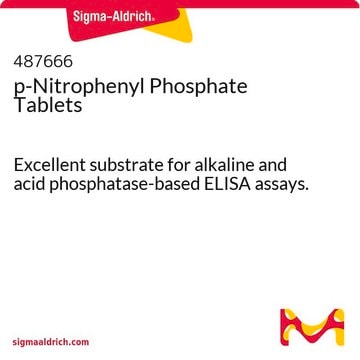Transportation information can be found in Section 14 of the product's (M)SDS.To access the shipping information for this material, use the link on the product detail page for the product.
N7653
p-Nitrophenyl Phosphate Liquid Substrate System
alkaline phosphatase substrate, liquid
Synonym(s):
4-Nitrophenyl phosphate disodium salt solution, pNPP
About This Item
Recommended Products
Product Name
p-Nitrophenyl Phosphate Liquid Substrate System, liquid
form
liquid
Quality Level
shipped in
wet ice
storage temp.
−20°C
SMILES string
[Na+].[Na+].[O-][N+](=O)c1ccc(OP([O-])([O-])=O)cc1
InChI
1S/C6H6NO6P.2Na/c8-7(9)5-1-3-6(4-2-5)13-14(10,11)12;;/h1-4H,(H2,10,11,12);;/q;2*+1/p-2
InChI key
VIYFPAMJCJLZKD-UHFFFAOYSA-L
General description
Application
Biochem/physiol Actions
Caution
Physical form
Signal Word
Danger
Hazard Statements
Precautionary Statements
Hazard Classifications
Eye Dam. 1 - Met. Corr. 1 - Repr. 2 - Skin Irrit. 2 - STOT RE 2 Oral
Target Organs
Kidney,Liver,Blood
Storage Class Code
8B - Non-combustible corrosive hazardous materials
WGK
WGK 3
Flash Point(F)
Not applicable
Flash Point(C)
Not applicable
Choose from one of the most recent versions:
Already Own This Product?
Find documentation for the products that you have recently purchased in the Document Library.
Customers Also Viewed
-
What is the Department of Transportation shipping information for this product?
1 answer-
Helpful?
-
-
What is the concentration of Product N7653, p-Nitrophenyl Phosphate Liquid Substrate System?
1 answer-
The concentration of this product is considered proprietary.
Helpful?
-
-
What type of application can Product N7653, p-Nitrophenyl Phosphate Liquid Substrate System, be used in?
1 answer-
This product is recommended for ELISA (microwell) procedures and is not recommended for membrane applications.
Helpful?
-
-
How should Product N7653, p-Nitrophenyl Phosphate Liquid Substrate System, be used?
1 answer-
Information on usage is found in our product information sheet (under Documents, above).
Helpful?
-
Active Filters
Our team of scientists has experience in all areas of research including Life Science, Material Science, Chemical Synthesis, Chromatography, Analytical and many others.
Contact Technical Service









